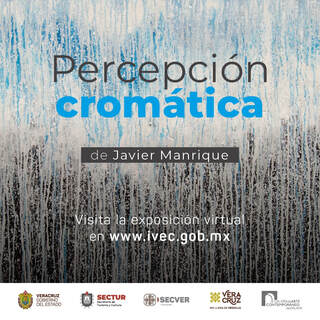
Chromatic Perception (Virtual exhibit)
Galería de Arte Contemporáneo de Xalapa
http://www.ivec.gob.mx/exposiciones/Percepcion/
Any landscape is a condition of the spirit
Henri-Fréderic Amiel
Javier Manrique’s recent paintings are the result of a landscape abstraction and synthesis process.
A landscape is a reading of the physical and aesthetical characteristics of the geographic space, but also of the intellectual and spiritual conditions that it awakens in its viewer.
In abstract landscapes space is stripped of its representational qualities and all its visual constituents are synthetized to obtain its essence, an essence that Manrique suggests through fields of color.
Here, the object of painting is not the image but the experience. Representation becomes secondary, even superfluous, and what comes first is the compositional and chromatic richness—or simplicity—through which the artist engages in the impossible task of showing his most intimate perception of things.
The abstract landscape doesn’t stop symbolizing a territory but, beyond a mere generality, this is a non-specific, non-identifiable one. If we think on geography as a notion rather than a fact, we’ll find ideal spaces in it or ones that have been sublimated through an economy of elements. By existing in a painting, those geographies are materialized.
Manrique makes an abstraction even of minimalism, until color dominates and articulates the way and the rhythm of the glance. Through his work, Manrique says that there is a suggestion wherever there is an essence. And, thus, forests, caves, skies, and soils are reduced to expressive brush strokes and droplets crashed against the canvass, or dripping down through it and creating profundity and vibration. These paintings aim to spontaneously evoke immaterial places which attract towards the realm of the visible the invisibility of emotions. There is no discourse guiding or limiting the viewer, just an incentive to mix those throbbing, stirring, shaking color areas with one’s own experience.
Chromatic Perception is an invitation to interiorize space and to contemplate color and its subtle language.
Maliyel Beverido
October, 2020
(tr. Tiosha Bojorquez Chapela)
Galería de Arte Contemporáneo de Xalapa
http://www.ivec.gob.mx/exposiciones/Percepcion/
Any landscape is a condition of the spirit
Henri-Fréderic Amiel
Javier Manrique’s recent paintings are the result of a landscape abstraction and synthesis process.
A landscape is a reading of the physical and aesthetical characteristics of the geographic space, but also of the intellectual and spiritual conditions that it awakens in its viewer.
In abstract landscapes space is stripped of its representational qualities and all its visual constituents are synthetized to obtain its essence, an essence that Manrique suggests through fields of color.
Here, the object of painting is not the image but the experience. Representation becomes secondary, even superfluous, and what comes first is the compositional and chromatic richness—or simplicity—through which the artist engages in the impossible task of showing his most intimate perception of things.
The abstract landscape doesn’t stop symbolizing a territory but, beyond a mere generality, this is a non-specific, non-identifiable one. If we think on geography as a notion rather than a fact, we’ll find ideal spaces in it or ones that have been sublimated through an economy of elements. By existing in a painting, those geographies are materialized.
Manrique makes an abstraction even of minimalism, until color dominates and articulates the way and the rhythm of the glance. Through his work, Manrique says that there is a suggestion wherever there is an essence. And, thus, forests, caves, skies, and soils are reduced to expressive brush strokes and droplets crashed against the canvass, or dripping down through it and creating profundity and vibration. These paintings aim to spontaneously evoke immaterial places which attract towards the realm of the visible the invisibility of emotions. There is no discourse guiding or limiting the viewer, just an incentive to mix those throbbing, stirring, shaking color areas with one’s own experience.
Chromatic Perception is an invitation to interiorize space and to contemplate color and its subtle language.
Maliyel Beverido
October, 2020
(tr. Tiosha Bojorquez Chapela)